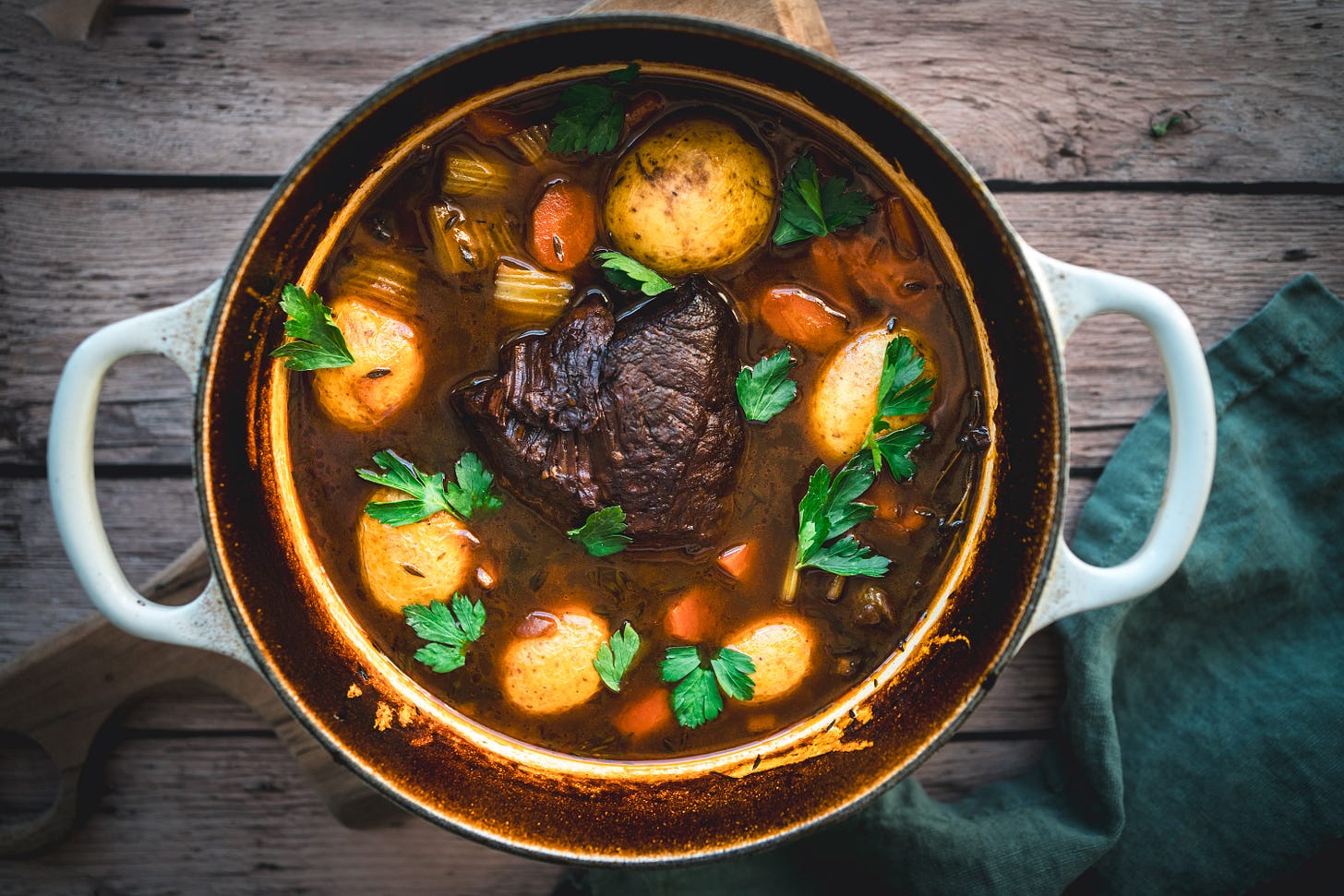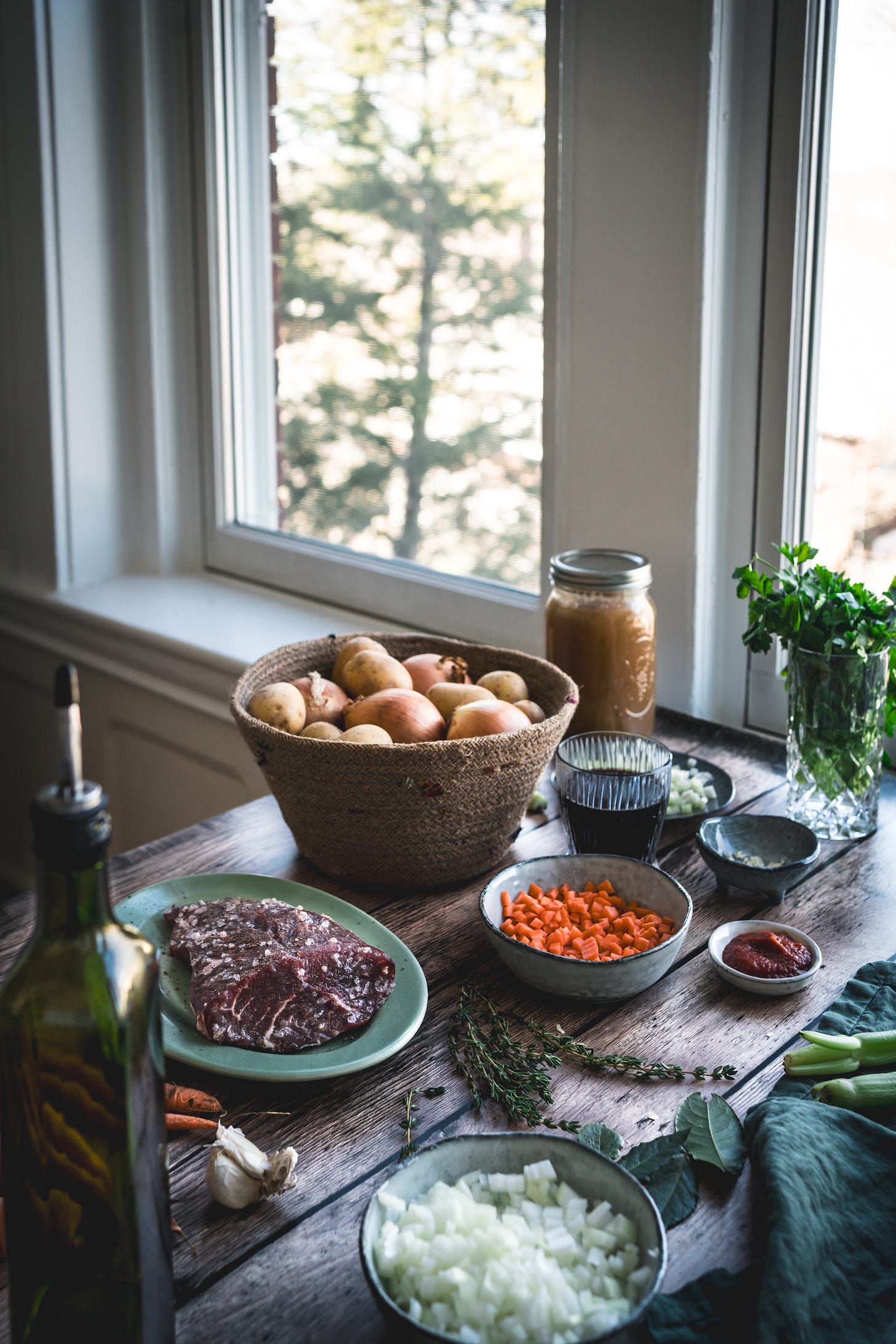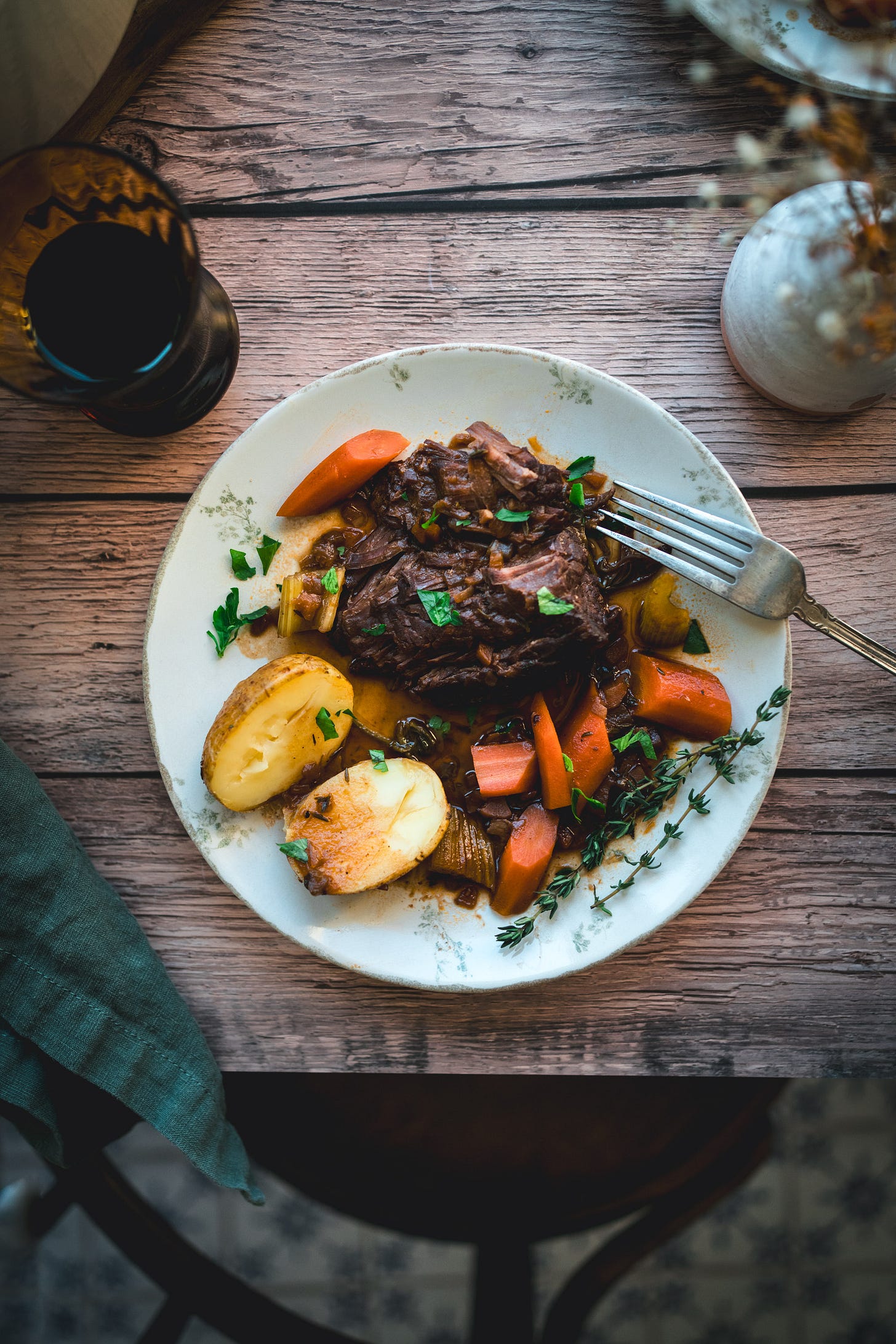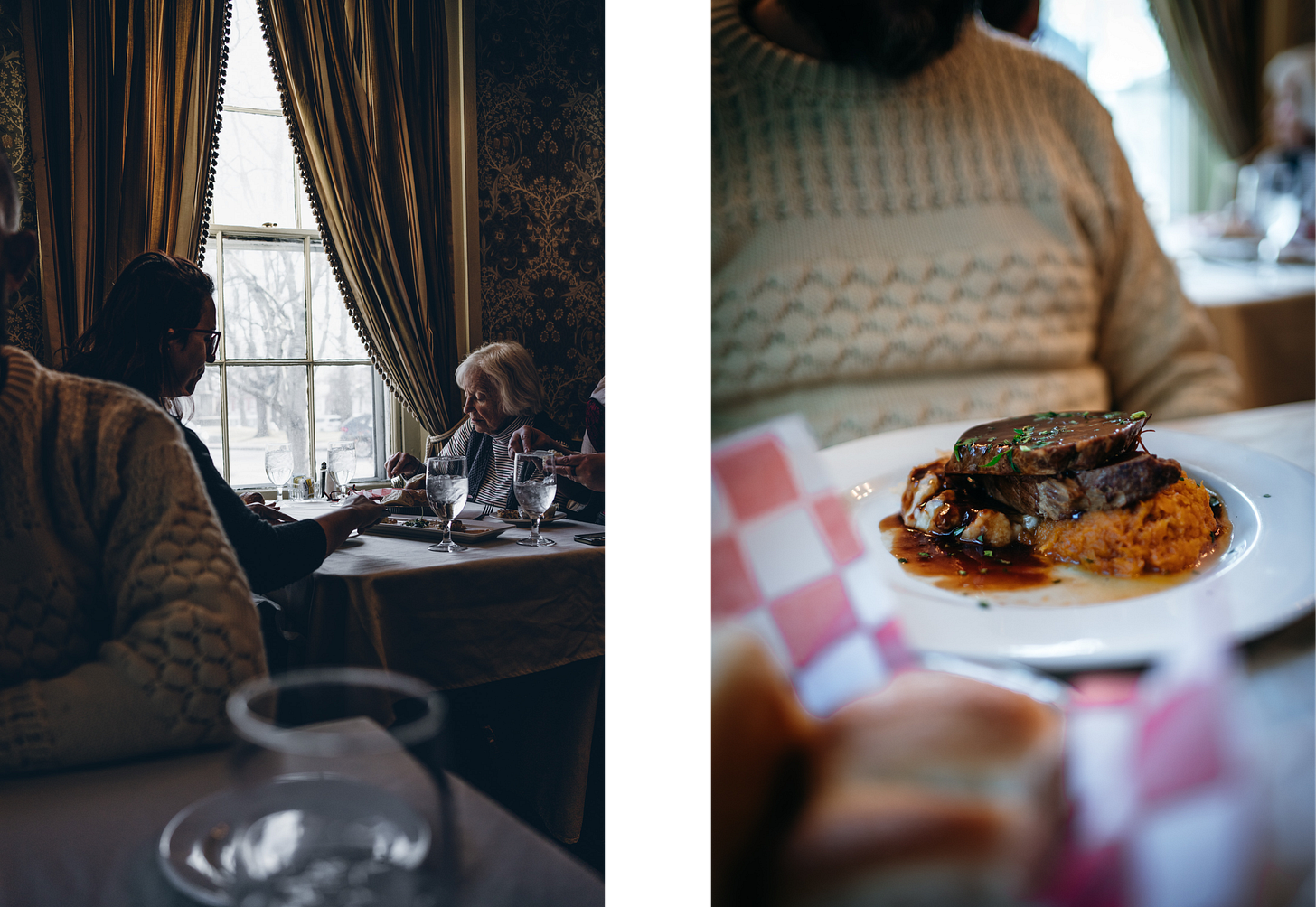Many of the most beloved New England classic dishes have an origin in Europe, and this one is no exception. Not only the techniques but also the ingredients it holds are all Old-World natives. Still, it’s considered one of the most American dishes. So much that it has the world Yankee in the title.
Writer Linda Lum says “survival in New England is dependent upon several key basics: wool socks, layers of flannel, L.L. Bean boots, puffy coats . . . and a recipe for Yankee pot roast”. I can see why.
What is the Yankee Pot Roast
According to Taste Atlas, “a pot roast is an American dish usually based on a tougher cut of beef that is seared in a pan and simmered in stock or its own juices". The term seems contradictory: “pot” suggests cooking with water (as boiling), but “roast” implies browning the meat. It seems a contradiction, because you cannot both boil and roast meat, right?
Well, you sort of can. The correct term is braising. As explained by Britannica, it is:
The cooking of meat or vegetables by heating them slowly with oil and moisture in a tightly sealed vessel. Braising differs from stewing, in which the food is immersed in liquid, and from covered roasting, in which no liquid is added. Braising is a combination of covered roasting and steaming.
There you go. This staple of winter in New England takes hours to make but actually involves little cooking as the pot does it all. It is a fantastic way to utilise less noble parts of the animal and get all the flavour they have secretly encapsulated. It also uses lots of winter vegetables that make the stew extra tasty. The key elements for this dish are the following:
The Meat
What I like the most about this recipe is that it uses cuts of the beef that traditionally would have been considered less desirable. Actually, this is how this dish was born: as a way to make tougher meats more (or very) palatable. The most typical cut to use is the chuck (higher part of the neck). But the brisket (lower part of the neck), the shoulder and the eye of round (part of the butt) are also good options.
The meat needs to be browned so it can check the part of the “roast” from the name. For that, everyone has a technique. Some decide to flour the meat before searing it to accelerate the browning, but I think it’s kind of cheating. If you can find the time, what works best is to salt the meat evenly and leave it to “cure” overnight or longer in the fridge. Uncovered. What you are doing with this is two things: you are making sure the meat is going to be properly seasoned and you are also helping break the proteins with the salt (which will make it more tender later on), but also you are drying the outside so it browns better as it has less moisture.
With the browning the meat transforms. It is called the Maillard Reaction and it is a chemical process in which lots of complex flavours and aromas are created in exchange of sugar when the meat protein gets some heat. This not only makes meat sexy but also it avoids the unpleasant boiled flavour we definitely don’t need.
The Aromatics
After browning the meat, you want to create a nice layer of vegetable flavour. This is why the recipe calls for chopped onions, carrots and celery to be cooked with oil in the meaty pan until tender. Then you may add some chopped garlic until fragrant (30 seconds). This is what the French call mirepoix. We Spaniards say sofrito, but it’s all the same.
The aromatics may vary, though. I listed the ones that are most traditional for this recipe and that I have seen repeated the most times. Still, the good thing about this dish is to adapt it to the aromatics you like or the ones you have in hand.
The Braising Liquid and Flavourings
The next step is to keep building the flavour. Remember, everything you add to the pot you will have to eat, so be sparse with the salt. It will all reduce and concentrate with time.
Many cooks add some tomato paste or crushed tomatoes here, it brings acidity and extra savouriness. You mix it well with the other vegetables after adding the red wine to deglaze. Deglazing is another great technique to keep all the flavours in. It basically means to add liquid (wine in this case) to a pan where there’s brown bits and cook it at high heat so it all falls in the solution.
After that you need to add the stock. Probably most home cooks will opt for a store-bought option but I think if you can, it’s always better to do it yourself. You will need to do it at least the day before because it needs around 7 hours of slow cooking, but it’s worth it!
I may be a romantic but I think there’s something beautiful in knowing you have given a second chance to parts of the animal that otherwise would have been discarded. I made the broth with beef bones (oxtail and marrow bones). I roasted them first in the oven with carrots, onions, parsnips and rutabaga and then I transferred everything to a stock pot and added bay leaves, parsley, thyme and peppercorns and enough water to cover everything. The super slow cooking meant that the bones had time to release all the collagen which will make your pot roast thick without needing any flour! Also, it freezes great and it’s fantastic to know you have something delicious home made in the freezer to add to soups or sauces anytime.
You will include the same aromatic herbs to the pot roast (bay leaves, fresh parsley and thyme), so you are using the bunch twice. And then… let it cook. For 4 hours.
The Vegetables
I didn’t mention it before, but what makes a pot roast a “Yankee” one is this last step. So far so good. You could cook it for a bit longer and you’d be done. But the New Englanders thought “why not give it more oomph and add more vegetables”?
So here is when you take the pot out of the oven and put in more carrots, baby potatoes and celery cut in large pieces. Some also add pearl onions or other root vegetables, it is a matter of taste now. The idea is that with only 70 minutes left of cooking time, the vegetables will come out perfectly done, and will be the ideal complement to the succulent meat.
In his memoir/cookbook Grandma’s Cooking (1955), journalist Allan Keller describes the times spent in Connecticut eating his grandmother’s Yankee pot roast. Emphasising the fact that such a dish is made out of simplicity and patience he states:
Like any great masterpiece, a Yankee pudding, pie, or roast is not dashed off in a trice; but when the lid is lifted and the aromas drift through the kitchen, it is like the spring that follows a hard, cold winter.

When was it invented
To respond this question we have different options. We can look into when the Yankee pot roast was invented as an American dish, and this will take us only two hundred years back. We can also look into when was it created in France, where the direct relative comes from, and we know the recipe was first recorded in a cookbook dated on 1651. The third option is to understand when the technique that makes the dish was conceived, and for that, my friends, we need to go baaaaack in time. To the very beginning actually.
Harvard anthropologist Richard Wrangham in his book Catching Fire: How Cooking Made us Human (2009) explains a theory that as a food journalist I really want to be true. He believes what made us human (what made our brains bigger, our jaws smaller and even our societies more complex) was the fact that we started cooking our food. Half a million years ago, before taming fire, hominids were not very dissimilar to nowadays apes in terms of food habits. They would eat raw fruits, seeds and the occasional wild game. This involved not only a lot of foraging but also a long time spent chewing, specially when it came to meat.
Do not think of the beautifully prepared carpaccio or tartare (that actually have been tenderised by adding citrus and pounding the meat) but of a carcass of a wild animal with its tough meat and tendons. Once Homo erectus discovered the power of an open fire to keep predators away and to bring warmth to cold nights, it didn’t take long until they became “cookavores”, according to Wrangham. By cooking the meats and plants on the fire pit they were actually making them more digestible, and releasing more calories and nutrients which made their brains more complex and therefore more intelligent.
Bringing some national pride to the table I will say that Spaniard food historian Felipe Fernández-Armesto said something very similar first in his book Food. A History (2004) and also mentioned the second most important food revolution: boiling and braising. This meant that the use of fire was not direct but the food was heated through liquid in a container. Slow cooking at low heat is what melts the tough connective tissue between the muscle fibers. It turned a chewy piece of meat into a melt-in-your-mouth meal.
Since then we have been doing it everywhere. Braising dishes are making carnivores happy all over the world. Still, it was the French that gave it the name we use now, and they also created the dish that Americans call “pot roast”. Harold McGee tells us in Food&Cooking (1984), that the world to braise originated in the 18th century and it comes from the French world braiser defining “live coals”, which were piled up under and atop a cooking pot. One of these brasing dishes was boeuf à la mode, which first appearance in a cookbook was in 1651 in the classic Le nouveau cuisinier françois by François-Pierre La Varenne. The modern recipe will sound very familiar, though this one had no vegetables in it. The beef was browned in lard, put in a pot with some stock, a bouquet garni (aromatic herbs) and spices, and braised until the meat was ready to serve with its sauce.
In 1792, the first restaurant à la carte, allowing customers to choose the dishes from a menu, opened in Paris. It was first called Méot, taking the name of the restaurant’s founders, but when it changed owner, it was rebaptized Le Boeuf à la Mode and transformed into a fine dishing establishment. On the outside of the restaurant there was a hanging sign of a cow dressed up with a long scarf and a feathered hat. À la mode, fashionable.
The dish is a classic in France and depending on the region it is often called boeuf mode, boeuf carottes or daube de boeuf as
, a fellow Substack writer tells us. In the United States it arrived with the stylish name and we find it for the first time in a written form in Amelia Simmons' American Cookery, published in 1796. In this first American cookbook alamode had become a verb as she writes the recipe “to alamode a round of beef”.To a 14 or 16 pound round of beef, put one ounce falt-petre, 48 hours after ftuff it with the following: one and half pound beef, one pound fait pork, two pound grated bread, chop all fine and rub in half pound butter, fait, pepper and cayenne, fummer favory, thyme; lay it on fcewers in a large pot, over 3 pints hot water (which it muft occafionally be fupplied with,) the fteam of which in 4 or 5 hours will 15 tender the round tender if over a moderate fire; when tender, take away the gravy and thicken with flour and butter, and boil, brown the round with butter and flour, adding ketchup and wine to your tafte.
Before that we find the recipe in a classic British cookbook from the 1747, The Art of Cookery Made Plain and Easy, calling for leg of mutton or piece of beef, wine or ale, mushrooms, and an assortment of spices. Perhaps it was because of the spices that the recipe became so popular and crossed so many borders as the 18th century spice-trade was blooming.
What made it Yankee
As a Spaniard, the word Yankee or even yanqui had always had a bad shadow. It sounded like a not very nice way to call the people from the United States. After moving here, I discovered that Americans use it as well, and proudly. For example, the baseball team from New York are the New York Yankees, and there’s a magazine here in New England called Yankee.
The difference is that here in the United States the term specifically refers to residents of New England. During the Civil War Yankee was used by Southerners to describe their rivals from the Union. And after that the name stayed to define New Englanders. There are several theories regarding the origin of the name. Some say it comes from a Dutch word as many people from that country settled in the north-east part of the country. Others think it may have come from the Cherokee word eankee, meaning “coward”. What we know is that the British used it in the early 1700s to describe the soldiers in the American colonies, and so it has come to our days with the children’s song Yankee Doodle.
The New Englanders, or Yankees, made the beouf à la mode theirs by simplifying the techniques, skipping the expensive spices and adding root vegetables, which is pretty much the only thing that used to grow up here during the cold winters. It is not clear when the name changed, but we know it was served at Ellis island to hungry immigrants on 1940 as “Yankee pot roast”.
Ellis Island authorities said food for temporary guests was good. PM’s representatives were hungry. The food was excellent. They were served tomato soup, Yankee pot roast with vegetable sauce, boiled potatoes, stewed corn, bread and butter, stewed figs and coffee.’
The dish is now regarded as a family recipe eaten at home and shared when relatives and friends come by. Writer Rachel Ellner dislikes the fact that many modern cookbooks and specialty magazines from New England don’t offer a recipe of the stew. She spoke with food historian Sandra Oliver and shared her insights: “If I were to take a guess, it would be that pot roast sounds too darn homely, trying to fathom the trend. Someone thinks of something brown and moist. . . . It doesn’t have pizzazz.”
Maybe this is why you cannot find it in most restaurants and pubs nowadays. You need to go to very homely dinners or to historic restaurants like the one in Concord’s Colonial Inn, opened at 1716. There you will be presented a Yankee pot roast that is served with a piece of round eye, mashed potatoes, butternut squash and gravy. If you get to seat by the window you can imagine how American soldiers won their first battle for Independence on April 19, 1775. While eating the made-tender meat you can hear "shot heard 'round the world" for liberty and self government being fired. And think how that French dish made with an ancient technique was made American in the hands of the Yankees.











